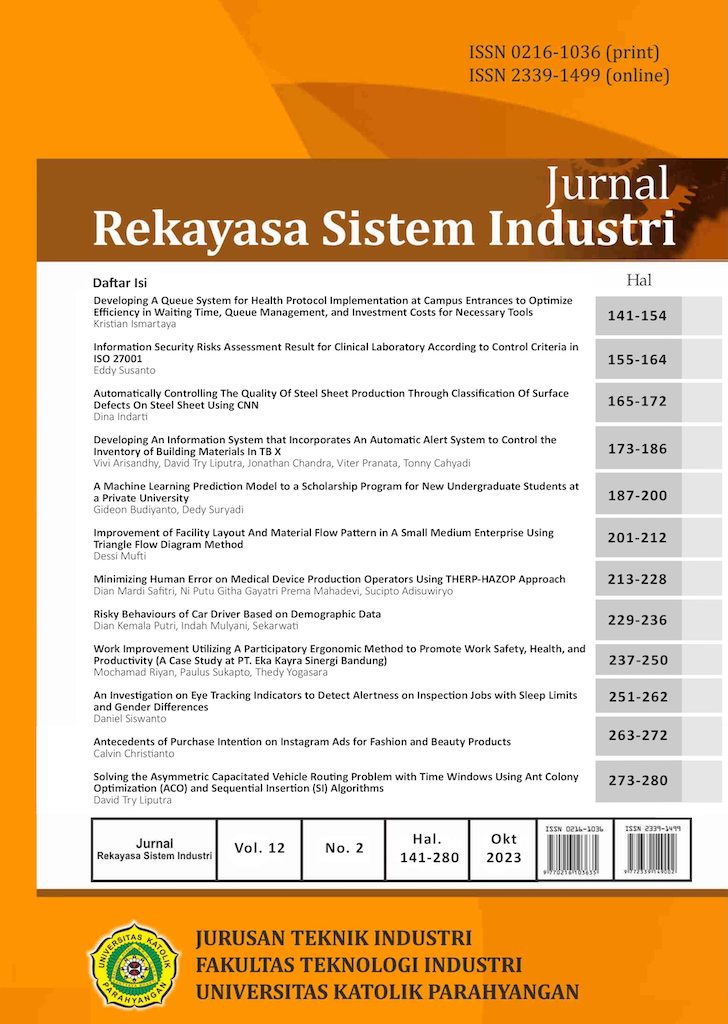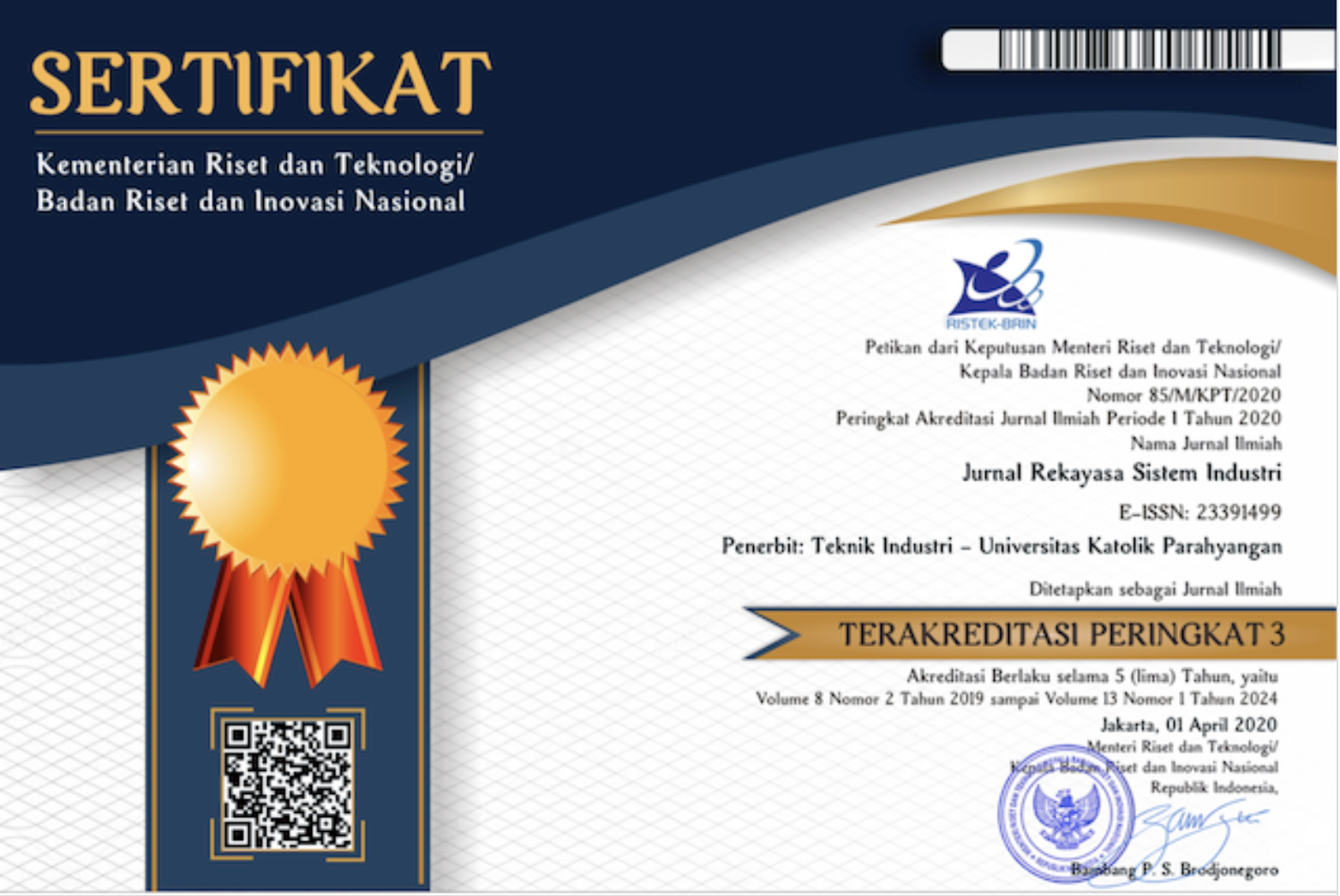Kajian Indikator Eye Tracking untuk Deteksi Kewaspadaan pada Pekerjaan Inspeksi dengan Batasan Durasi Tidur dan Perbedaan Jenis Kelamin
DOI:
https://doi.org/10.26593/jrsi.v12i2.6846.251-262Kata Kunci:
ete tracking, okular, kewaspadaan, batasan durasi tidur, kecepatan sakadikAbstrak
Eye tracking (ET) sudah banyak digunakan untuk mendeteksi perubahan okular yang juga berkorelasi dengan kelelahan. Namun, sejauh ini belum diketahui apakah terdapat indikator ET yang mampu mendeteksi kelelahan yang berkaitan erat dengan penurunan kewaspadaan. Penelitian ini bertujuan menentukan indikator ET yang sensitif mendeteksi perubahan kewaspadaan akibat batasan durasi tidur (4 dan 8 jam) pada perbedaan jenis kelamin. Sebanyak 56 partisipan (28 pria, 21,32 1,16 tahun dan 28 wanita, 21,5 1,2 tahun) dilibatkan pada penelitian ini. Partisipan diminta melakukan simulasi inspeksi cacat (dirt, scratch, missing part, dan poor assembly) pada 50 senter sambil menggunakan eye tracker. Selain itu juga dilakukan pengujian kewaspadaan dengan Psychomotor Vigilance Task (PVT) dan Karolinska Sleepiness Scale (KSS). Hasil ANOVA menunjukkan durasi tidur memengaruhi mean RT, minor lapse, mean 1/RT, kecepatan sakadik, dan KSS. Sebaliknya, jenis kelamin memengaruhi mean 1/RT, diameter pupil, dan kecepatan sakadik. Selain itu, uji korelasi Pearson menunjukkan hubungan yang lemah antara indikator ET dan PVT. Meski demikian, kecepatan sakadik berpotensi mampu mendeteksi perubahan kewaspadaan karena dipengaruhi durasi tidur yang sangat terkait dengan kewaspadaan. Namun masih diperlukan penelitian lebih lanjut untuk memastikan hasil ini karena pada penelitian ini korelasi kecepatan sakadik dan indikator PVT masih menunjukkan hubungan yang lemah.
Referensi
Abe, T., Nonomura, T., Komada, Y. Asaoka, S., Sasai, T., Ueno, A., & Inoue, Y. (2011). Detecting Deteriorated Vigilance Using Percentage of Eyelid Closure Time During Behavioral Maintenance of Wakefulness Tests. International Journal of Psychophysiology, 82, 269–274.
Ariyaya, A. (2021). Analisis Beban Kerja Fisiologis dan Psikologis pada Operator (Studi Kasus: PT. Ravana Jaya). Gresik: Universitas Muhammadiyah.
Baiasu, A-M. & Dumitrescu, C. (2021). Contributions to Driver Fatigue Detection based on Eye-tracking. International Journal of Circuits, Systems and Signal Processing, 15, 1-7.
Basner, M. & Dinges, D.F. (2011). Maximizing Sensitivity of The Psychomotor Vigilance Test (PVT) to sleep loss. Sleep, 34(5), 581-591.
Basner, M. & Rubinstein, J. (2011). Fitness for Duty: A 3-minute Version of The Psychomotor Vigilance Test Predicts Fatigue Related Declines in Luggage Screening Performance. J Occup Environ Med., 53(10), 1146-1154.
Basner, M., Mollicone, D., & Dinges, D.F. (2011). Validity and Sensitivity of a Brief Psychomotor Vigilance Test (PVT-B) to Total and Partial Sleep Deprivation. Acta Astronaut, 69(11-12), 949-959.
Beijamini, F., Silva, A.G.T., Peixoto, C.A.T, & Louzada, F.M. (2008). Influence of Gender on Psychomotor Vigilance Task Performance by Adolescents, Brazilian Journal of Medical and Biological Research, 41, 734-738.
Belenky, G., Wesensten, N.J., Thorne, D.R., Thomas, M.L., Sing, H.C., Redmond, D.P., Russo, M.B., & Balkin, T.J. (2003). Patterns of Performance Degradation and Restoration during Sleep Restriction and Subsequent Recovery: A Sleep Dose-response Study. J Sleep Res, 12, 1–12.
Bergstrom, J. R., & Schall, A. J. (2014). Eye Tracking in User Experience Design. San Francisco, CA: Morgan Kaufmann.
Blanca, M.J., Alarcon, R., Arnau, J., Bono, R., & Bendayan, R. (2017). Non-normal Data: Is ANOVA Still a Valid Option? Psicothema, 29(4), 552-557.
Blatter, K., Graw, P., Münch, M., Knoblauch, V., Wirz-Justice, A., & Cajochen, C. (2006). Gender and Age Differences in Psychomotor Vigilance Performance Under Differential Sleep Pressure Conditions. Behavioural Brain Research, 168, 312-317.
Brown, I.D. (1994). Driver Fatigue. Human Factors, 36(2), 298-314.
Budiono, A. M. S., Jusuf, S. M. S., & Pusparini, A. (2003). Bunga Rampai Hiperkes dan KK. Semarang: BP Universitas Diponegoro.
Chua, E. C. P., Tan, W. Q., Yeo, S. C., Lau, P., Lee, I., Mien, I. H., Puvannendran, K., & Gooley, J. J. (2012). Heart Rate Variability Can Be Used to Estimate Sleepiness-Related Decrements in Psychomotor Vigilance During Total Sleep Deprivation. Sleep, 35, 325-334.
Davies, D.R., & Parasuraman, R. (1982). The Psychology of Vigilance. New York, NY: Academic Press.
Dawson, D., Searle, A.K., & Peterson, J.L. (2014). Look Before You (S)leep: Evaluating The Use of Fatigue Detection Technologies within A Fatigue Risk Management System for The Road Transport Industry. Sleep Medicine Reviews, 18, 141 – 152.
De Gennaro, L. Ferrara, M., Urbani, L., & Bertini, M. (2000). Oculomotor Impairment After 1 Night of Total Sleep Deprivation: A Dissocation Between Measures of Speed and Accuracy. Clinical Neurophysiology: Official Journal of the International Federation of Clinical Neurophysiology, 111(10), 1771-1778.
Desai, A. V., & Haque, M. A. (2006). Vigilance Monitoring for Operator Safety: A Simulation Study on Highway Driving. J Safety Res., 37(2), 139-47.
Dewi, S. V. (2014). Pengaruh Kafein pada Cokelat (Theobroma Cacao) Terhadap Waktu Reaksi Sederhana Pria Dewasa. Bandung: Universitas Kristen Maranatha.
Di Milia, L., Smolensky, M., Costac, G., Howarth, H., Ohayon, M., & Philip, P. (2011). Demographic Factors, Fatigue, and Driving Accidents: An Examination of the Published Literature. Advancing Fatigue and Safety Research, 516-532.
Di Stasi, L. L., Catena, A., Cañas, J. J., Macknik, S. L., & Martinez-Conde, S. (2013). Saccadic Velocity as an Arousal Index in Naturalistic Tasks. Neuroscience and Biobehavioral Reviews, 37(5), 968-975.
Doran, S.M., Van Dongen, H.P., & Dinges, D.F. (2001). Sustained Attention Performance During Sleep Deprivation: Evidence of State Instability. Archives Italiennes de Biologie, 139, 253–267.
Dunn, N., & Williamson, A. (2012). Driving Monotonous Routes in a Train Simulator: The Effect of Task Demand on Driving Performance and Subjective Experience. Ergonomics, 55, 997-1008.
Hastjarjo, T.D. (2014). Rancangan Eksperimen. Yogyakarta: Universitas Gadjah Mada.
Johns, M.W. (2009). What is Excessive Daytime Sleepiness? Sleep Deprivation: Causes, Effects, and Treatment (Chapter 2). Nova Science Publisher, Inc.
Kaida, K., Takahashi, M., Akerstedt, T., Nakata, A., Otsuka, Y., Haratani, T., & Fukusawa, K. (2006). Validation of The Karolinska Sleepiness Scale Against Performance and EEG Variables. Clinical Neurophysiology, 117, 1574- 1581.
Killgore, W. D. S. (2010). Effects of Sleep Deprivation on Cognition. Progress in Brain Research, 185, 105–129.
Kooiker, M. J., Pel, J. J., Verbunt, H. J., de Wit, G. C., van Genderen, M.M., & van der Steen, J. (2016). Quantification of Visual Function Assessment Using Remote Eye Tracking in Children: Validity and Applicability. Acta Ophthalmol, 94, 599-608.
Laerd Statistics, Correction for Violation of Sphericity in Repeated Measures Designs, [Online], Diakses dari: https://statistics.laerd.com/statistical-guides/sphericity-statistical-guide-2.php [2022, 10 Juli].
Lauderdale, D.S., Knutson, K.L., Yan, L.L., Rathouz, P.J., Hulley, S.B., Sidney, S., & Liu, K. (2006). Objectively Measured Sleep Characteristics Among Early- middle-aged Adults: The CARDIA Study. Am. J. Epidemiol, 164, 5–16.
Lerman, S. E., Eskin, E., Flower, D. J., George, E. C., Gerson, B., Hartenbaum, N., Hursh, S. R., & Moore-Ede, M. (2012). Fatigue Risk Management in The Workplace. Journal of Occupational and Environmental Medicine, 54(2), 231-258.
Lestari, W.S. (2016). Faktor-faktor yang Berhubungan dengan Kelelahan pada Pekerja Pembuat Tahu di Pabrik Tahu Kelurahan Sumurrejo Kecamatan Gunungpati Semarang. Semarang: Universitas Negeri Semarang.
Mahardika, R. (2009). Quality Control PT. Tiga Pilar Sejahtera Food Tbk (Unit Candy) PT. Poly Meditra Indonesia. Surakarta: Universitas Sebelas Maret.
Mao, T., Dinges, D.F., Deng, Y., Zhao, K., Yang, Z., Lei, H., Fang, Z., Yang, F.N., Galli, O., Goel, N., Basner, M., & Rao, H. (2021). Impaired Vigilant Attention Partly Accounts for Inhibition Control Deficits After Total Sleep Deprivation and Partial Sleep Restriction. Nature and Science of Sleep, 13, 1545-1560.
Mathis, J . & Hess, C.W. (2009). Sleepiness and Vigilance Test. Swiss Med Wkly, 139(15-16), 214-219.
May, J. & Baldwin, C. L. (2009). Driver Fatigue: The Importance of Identifying Causal Factors of Fatigue When Considering Detection and Countermeasure Technologies. Transportation Research Part F, 12, 218-224.
McClelland, L. E., Pilcher, J. J., & Moore, D. D. (2010). Oculomotor Measures as Predictors of Performance During Sleep Deprivation. Aviation, Space, and Environmental Medicine, 81(9), 833-842.
Nielson, S.A., Buysse, D.J., & Kay, D.B. (2021): Fidelity of Information Processing on A Psychomotor Vigilance Task Predicts Changes in Self-reported Sleepiness Ratings. Nature and Science of Sleep, 13, 659-671.
Oken, B. S, Salinsky, M. C., & Elsas, S. M. (2006). Vigilance, Alertness, or Sustained Attention: Physiological Basis and Measurement. Clin Neurophysiol, 117(9), 1885-901.
Rahadhi, A., dan Sriyanto, S. (2016). Pengaruh Beban Kerja Mental, Kelelahan Kerja, dan Tingkat Kantuk Terhadap Penurunan Tingkat Kewaspadaan Perawat (Studi Kasus di Instalasi Gawat Darurat Rumah Sakit Umum Puri Asih Salatiga). Industrial Engineering Online Journal, 5(2).
Ramadhani, M,10 Dampak Buruk dari Kurang Tidur (3-Habis), [Online], Diakses dari:https://www.republika.co.id/berita/gaya-hidup/info sehat/ 13 /01 /31 /mhhaup-10-dampak-buruk-dari kurang-tidur-3habis [2022, 21 Februari].
Rice, V. J., & Liu, B. (2017) The Relationship Between Sustained Attention and Mindfulness Among U.S. Active-Duty Service Members and Veterans. Advances in Intelligent Systems and Computing, 487, Springer, Cham.
Sadeghniiat-Haghighi, K., Yazdi, Z. (2015). Fatigue Management in the Workplace. Industrial Psychiatry Journal, Industrial Psychiatry Journal.
Sargezeh, B. A., Tavakoli, N., & Daliri, M. R. (2019). Gender-Based Eye Movement Differences in Passive Indoor Picture Viewing: An Eye-Tracking Study. Physiology & Behavior, 206, 43-50.
Sanchis-Gimeno, J. A., Sanchez-Zuriaga, D., & Martinez-Soriano, F. (2012). White-to-white Corneal Diameter, Pupil Diameter, Central Corneal Thickness and Thinnest Corneal Thickness Values of Emmetropic Subjects. Surg Radiol Anat, 34, 167-170.
Sari, N. A. (2021). Wah, Orang dengan Pupil Mata Besar Konon Lebih Cerdas, [Online], Diakses dari: https://mediaindonesia.com/weekend/410265/wah-orang-dengan-pupil-mata-besar-konon-lebih-cerdas [2022, 31 Agustus].
Seidel, W.T., Joschko, M. (1991). Assessment of Attention in Children, The Clinical Neuropsychologist, 5, 53-66.
Seideman, J. A., Stanford, T. R., & Salinas, E. (2018). Saccade Metrics Reflect Decision-Making Dynamics During Urgent Choices. Nat Commun, 9, 2907.
Schleicher, R., Galley, N., Briest, S. & Galley, L. (2008). Blinks and Saccades as Indicators of Fatigue in Sleepiness Warnings: Looking Tired? Ergonomics, 51, 982-1010.
Schmider, E., Ziegler, M., Danay, E., Beyer, L., & Bühner, M. (2010). Is It Really Robust? Reinvestigating the Robustness of ANOVA Against Violations of the Normal Distribution Assumption. Methodology European Journal of Research Methods for the Behavioral and Social Sciences, 6(4), 147-151.
Shahraki, S., Bin Abu Bakar, N. (2011). Effects of Nervous Fatigue on Workforce Productivity, Int J Acad Res, 3, 370‑378.
Soccolich, S.A, Blanco, M., Hanowski, R.J, Olson, R.L., Morgam, J.F., Guo, F., & Wu, S. (2013). An Analysis of Driving and Working Hour on Commercial Motor Vehicle Driver Safety Using Naturalistic Data Collection. Accident Analysis and Prevention, 58, 249-258.
Steege, L.M.B. & Nussbaum, M.A. (2013). Dimension of Fatigue as Predictors of Performance: A Structural Equation Modelling Approach Among Registered Nurses. IIE Transaction on Occupational Ergonomics and Human Factors, 16-30.
Stollery, B. (2006). Vigilance. (Dalam: Karwowski, W.), International Encyclopedia of Ergonomics and Human Factors, 01, 964-967. Kentucky: Taylor & Francis.
Tabai, B.H., Bagheri, M., Sadeghi-Firoozabadi, V., & Shahidi, V. (2017). The Relationship Between Train Drivers’ Attention and Accident Involvement. 2017 4th International Conference on Transportation Information and Safety, Banff, Canada, 1034-1039.
Thiffault, P., & Bergeron, J. (2003a). Fatigue and Individual Differences in Monotonous Simulated Driving. Personality and Individual Differencess, 34, 159-176.
Tobii Pro, Are Pupil Size Calculations Possible with Tobii Eye Trackers?, [Online], Diakses dari: https://www.tobiipro.com/learn-and-support/learn/eye-tracking-essentials/is-pupil-size-calculations-possible-with-tobii-eye-trackers/ [2022, 21 Juli].
Tobii Pro. (2016). Tobii Pro Glasses 2 User’s Manual. Sweden: Tobii Pro AB.
Tobii Pro. (2021). Applications for Eye Tracking. [Online], Diakses dari: https://www.tobiipro.com/application/ [2021,29 Desember].
Tyagi R., Shen, K., Shao, S., dan Li, X. (2009). A Novel Auditory Working-memory Vigilance Task for Mental Fatigue Assessment. Safety Science, 47, 967-972.
Warm, J. (1984). Sustained Attention in Human Performance. Wiley, Chichester.
Williamson, A., Lombardi, D.A., Folkard, S., Stutts, J., Courtney, T.K., & Connor, J.L. (2011). The Link Between Fatigue and Safety. Accident Analysis and Prevention, 43, 498-515.
Venker, C.C, Goodwin, J.L, Roe, D.J, Kaemingk, K.L, Mulvaney, S., Quan, S.F. (2007). Normative Psychomotor Vigilance Task Performance in Children Ages 6 to 11 - The Tucson Children’s Assessment of Sleep Apnea (TuCASA), Sleep Breath, 11, 217-224.
Yang, F.N., Xu, S., Chai, Y., Basner, M., Dinges, D.F., & Rao, H. (2018). Sleep Deprivation Enhances Inter-stimulus Interval Effect on Vigilant Attention Performance. Sleep J., 1-12.













